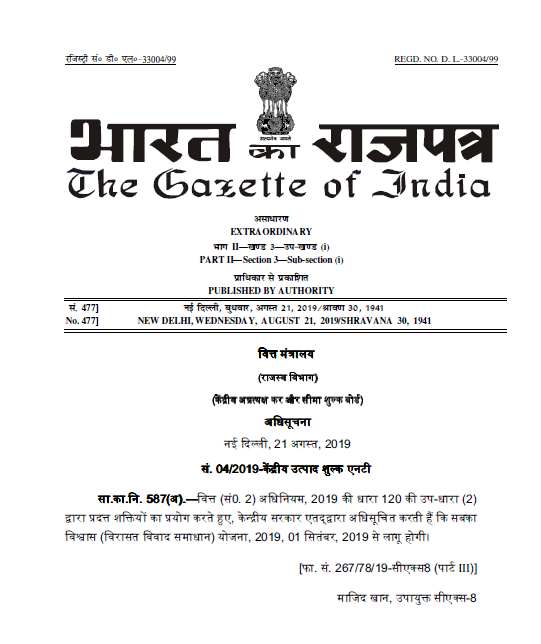Sabka Vishwas (Legacy Dispute Resolution) Scheme Rules, 2019
The government has issued the Sabka Vishwas (Legacy Dispute Resolution) Scheme Rules, 2019 on 21st August 2019 via Notification No. 05/2019 Central Excise-NT.
1. Short title and commencement.-
(1) These rules may be called the Sabka Vishwas (Legacy Disput Resolution) Scheme Rules, 2019.
(2) They shall come into force on the 1st day of September, 2019.
2. Definitions.-
In these rules, unless the context otherwise requires, –
(a) “Scheme” means the Sabka Vishwas (Legacy Dispute Resolution) Scheme, 2019, specified under Chapter V of the Finance (No.2) Act, 2019 (23 of 2019);
(b) “section” means the section of the Finance (No. 2) Act, 2019;
(c) “Form” means the Form annexed to these rules;
(d) Words and expressions used in these rules but not defined in these rules and defined in the Scheme shall have the meanings respectively assigned to them in the Scheme.
3. Form of declaration under section 125 .-
(1) The declaration under section 125 shall be made electronically at https://cbic-gst.gov.in in Form SVLDRS-1 by the declarant ,on or before the 31st December,2019.
(2) A separate declaration shall be filed for each case.
Explanation.- For the purpose of this rule, a “case” means –
(a) a show cause notice, or one or more appeal arising out of such notice which is pending as on the 30th day of June, 2019; or
(b) an amount in arrears; or
(c) an enquiry or investigation or audit where the amount is quantified on or before the 30th day of June, 2019; or
(d) a voluntary disclosure.
4. Auto acknowledgement.-
On receipt of the declaration, an auto acknowledgment bearing a unique reference number shall be generated by the system.
5. Constitution of designated committee.-
(1) The designated committee under section 126 shall consist of –
(a) the Principal Commissioner or Commissioner of Central Excise and Service Tax, as the case may be, and the Additional Commissioner or Joint Commissioner of Central Excise and Service Tax, as the case may be, in a case where the tax dues are more than rupees fifty lakh:
Provided that there shall be only one such designated committee in a Commissionerate of Central Excise and Service Tax;
(b) the Additional Commissioner or Joint Commissioner of Central Excise and Service Tax, as the case may be, and the Deputy Commissioner or Assistant Commissioner of Central Excise and Service Tax, as the case may be, in a case where the tax dues are rupees fifty lakh or less:
Provided that there will only be one such designated committee in a Commissionerate of Central Excise and Service Tax;
(c) the Principal Additional Director General (Adjudication) or Additional Director General (Adjudication),
Directorate General of Goods and Services Tax Intelligence (DGGI), and Additional Director or Joint Director, Directorate General of Goods and Services Tax Intelligence(DGGI), Delhi.
(2) The members of the designated committee mentioned in clause (a) and (b) of sub-rule (1) shall be nominated by the Principal Chief Commissioner or Chief Commissioner of Central Excise and Service Tax, as the case may be.
(3) The members of the designated committee mentioned in clause (c) of sub-rule (1) shall be nominated by Pr. Director General or Director General, Directorate General of Goods and Services Tax Intelligence (DGGI), as the case may be.
6. Verification by designated committee and issue of estimate, etc.-
(1) The declaration made under section 125, except when it relates to a case of voluntary disclosure of an amount of duty, shall be verified by the designated committee based on the particulars furnished by the declarant as well as the records available with the Department.
(2) The statement under sub-sections (1) and (4) of section 127, as the case may be, shall be issued by the designated committee electronically, within a period of sixty days from the date of receipt of the declaration under sub-rule (1) of rule 3, in Form SVLDRS-3 setting forth therein the particulars of the amount payable:
Provided that no such statement shall be issued in a case where the amount payable, as determined by the designated committee is nil and there is no appeal pending in a High Court or the Supreme Court.
(3) Where the amount estimated to be payable by the declarant exceeds the amount declared by the declarant, then, the designated committee shall issue electronically, within thirty days of the date of receipt of the declaration under sub-rule (1) of rule 3, in Form SVLDRS-2, an estimate of the amount payable by the declarant along with a notice of opportunity for personal hearing.
(4) If the declarant wants to indicate agreement or disagreement with the estimate referred to in sub-rule
(3) or wants to make written submissions or waive personal hearing or seek an adjournment, he shall file electronically Form SVLDRS- 2A indicating the same:
Provided that if no such agreement or disagreement is indicated till the date of personal hearing and the declarant does not appear before the designated committee for personal hearing, the committee shall decide the matter based on available records.
(5) On receipt of a request for an adjournment under sub-rule (4), the designated committee may grant the same electronically in Form SVLDRS-2B:
Provided if the declarant does not appear before the designated committee for personal hearing after adjournment, the committee shall decide the matter based on available records.
(6) Within thirty days of the date of issue of Form SVLDRS-3, the designated committee may modify its order only to correct an arithmetical error or clerical error, which is apparent on the face of record, on such error being pointed out by the declarant or suo motu by issuing electronically a revised Form SVLDRS-3.
7. Form and manner of making the payment.-
Every declarant shall pay electronically the amount, as indicated in Form SVLDRS-3 issued by the designated committee, within a period of thirty days from the date of its issue.
8. Proof of withdrawal of appeal from High Court or Supreme Court.-
Proof of withdrawal of appeal or writ petition or reference before a High Court or the Supreme Court, as the case may be, under sub-section (7) of section 127 shall be furnished electronically by the declarant.
9. Issue of discharge certificate.-
The designated committee on being satisfied that the declarant has paid in full the amount as determined by it and indicated in Form SVLDRS-3, and on submission of proof of withdrawal of appeal or writ petition or reference referred to in rule 8, if any, shall issue electronically in Form SVLDRS-4 a discharge certificate under sub-section (8) of section 127 within thirty days of the said payment and submission of the said proof, whichever is later:
Provided that in a case where Form SVLDRS-3 has not been issued by the designated committee by virtue of the proviso to sub-rule (2) of rule 6, the discharge certificate shall be issued within thirty days of the filing of declaration referred to in sub-rule (1) of rule 3.
Download full Sabka Vishwas (Legacy Dispute Resolution) Scheme Rules, 2019, below:
 ConsultEase Administrator
ConsultEase Administrator
Consultant
Faridabad, India
As a Consultease Administrator, I'm responsible for the smooth administration of our portal. Reach out to me in case you need help.








